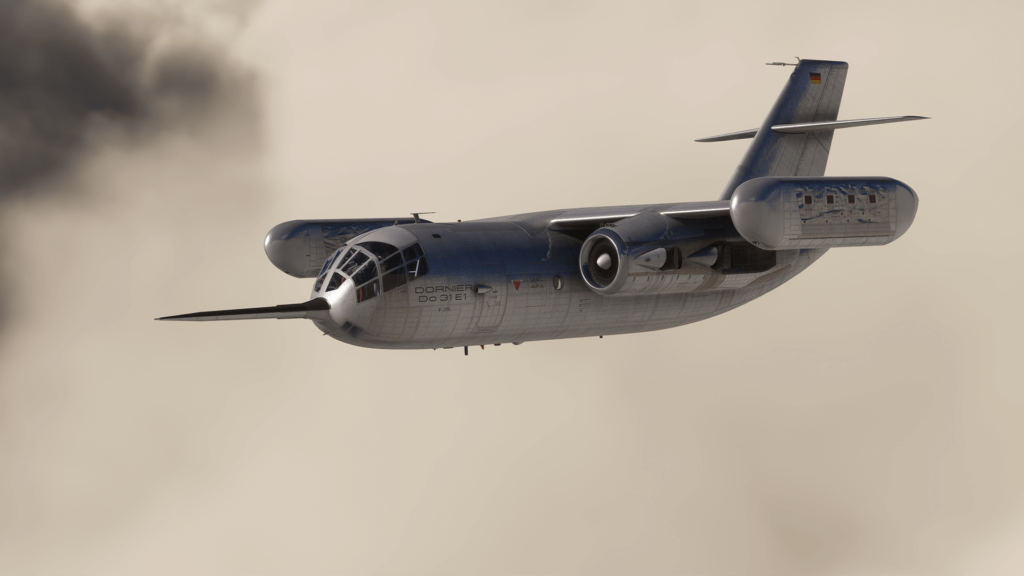Microsoft Flight Simulator pilots can now fly one of aviation’s greatest icons of innovation.
A MONUMENT OF AVIATION INGENUITY
The Dornier Do 31 is a jet-powered, vertical take-off and landing (VTOL), experimental military aircraft developed by the West German aviation manufacturer and historically renowned as the only jet-powered VTOL utility / transport aircraft ever created and flown. Although Dornier only produced three experimental prototypes and never entered serial production, the Do 31 remains an enduring monument of aerospace ingenuity.
BORN OF COLD WAR IMPERATIVE
The distinctive Do 31 was born out of an ambitious Cold War initiative by the West German military to create an eminently resilient air force. An initial attack by the Soviet Bloc focused on air bases and runways throughout West Germany, grounding their airplanes. To counter this threat, the West Germans hatched a plan in the early 1960s to create a new air force composed primarily of jet-powered VTOL aircraft. Such airplanes could operate out of traditional air bases, expeditionary airfields, or roads and highways, including Autobahns—any small stretch of concrete or asphalt would work.
The West German military’s plan included three VTOL aircraft: a fighter / interceptor: the EWR VJ 101; a surface attack platform: the VFW VAK-191B; and a large utility aircraft that could transport troops and cargo.
AN ENGINEERING MARVEL
While helicopters had proven their utility by the early 1960s, especially for military operations, they were limited in both speed and lift ability. Developing a jet-powered transport aircraft, however, presented engineers with tremendous hurdles like generating and directing adequate thrust to vertically lift an aircraft, transitioning it to horizontal flight, and then landing it vertically.
By the early 1960s, companies interested in jet-powered VTOL aircraft operation had proven the concept could work with experimental models. The Short SC.1, developed by United Kingdom aviation company Short Brothers, took its maiden flight on May 26, 1958. The Short SC.1 was followed by the first flight of the British Hawker Siddeley P.1127, the progenitor to the Hawker Siddeley Harrier, the world’s first production VTOL fighter / attack jet. Both were engineering breakthroughs that took years of development. The transport aircraft the West German military envisioned would be much larger, dramatically increasing the complexity. Dornier, famed for their flying boats and airliners, undertook the ambitious challenge in February, 1962, when the company and the West German military formally launched the project, designated the Do 31.
While Dornier had never built a VTOL aircraft, the company’s engineers had gained experience with short take-off and landing (STOL) exercises with their Do 29. That airplane, which took its maiden flight in late 1958, was an experimental, twin-engine, piston-powered, high-wing monoplane that used tilting engine-propeller systems to boost lift for take-off. The jet powered Do 31, intended to carry up to 36 combat loaded troops, 7,700 pounds of cargo, or some combination thereof, proved far more complex. It required the company to develop some of the most advanced aviation technology to that point in history including novel powerplant designs, high-strength airframe componentry, and an innovative flight control computer.
Dornier built three airframes with a group designation Do 31 E (“E” for “Experimental”): the Do 31 E1, the Do 31 E2, and the Do 31 E3. The E1 and the E3 were flying prototypes, while the E2 was a ground-based testbed.
The Do 31 featured a high-mounted main wing, a cruciform empennage, a capacious fuselage with a ramp-loading cargo system, and retractable tricycle landing gear. Its primary power source: two Rolls-Royce Pegasus BE.53/2 turbofan engines, each of which could produce up to 15,500 pounds of thrust. Each Pegasus was housed in a nacelle, one under each side of the main wing, and thrust from each was directed through four rotating exhaust ports called thrust vectoring nozzles. For complementary thrust and redundancy purposes—should one of the Pegasus engines fail mid-flight—Dornier crafted wingtip-mounted secondary thrust systems. Each wingtip featured a nacelle that housed four vertically oriented Rolls-
Royce RB-162-4D turbojet engines; each engine could generate up to 4,400 pounds of thrust, for a total of 17,600 pounds of thrust per wingtip. In total, the Do 31 was powered by ten engines capable of an aggregate 66,200 pounds of thrust. Only a few other aircraft in history have comprised ten or more engines, including Dornier’s Do X, a flying boat that was powered by 12 piston engines.
To provide control of the Do 31 throughout all its flight regimes, Dornier developed an extremely critical hybrid analog-digital computer, the DO-960. The aircraft simply would be too unstable to function without an adequate flight computer that could continuously solve a series of complex equations to maintain controlled flight. Digital computer technology and integrated circuit design were still in their infancy at this point and not fast enough to perform the specific types of solutions necessary (the microprocessor had yet to be developed). Dornier engineers solved this immense challenge by devising a novel computer system that fused aspects of analog calculation with components of digital computation.
The DO-960 maintained aircraft stability by taking pilot inputs and controlling flight surfaces, power output of each of the aircraft’s ten engines, the orientation of its thrust vector nozzles, and amount of bleed air ducted to nozzles in the aircraft’s tail. The Do 31 lifted off and hovered with downward-vectored thrust from the Pegasus engines combined with thrust from its wingtip turbojets. It then transitioned to horizontal flight through the rearward rotation of the main engine’s thrust vector nozzles.
The DO-960 remains one of history’s most notable computer developments and a brilliant example of technological innovation born of necessity. Although hidden within the confines of the unique aircraft’s form, the computer was one of the Do 31’s most crucial, and notable, features.
A NEW BREED TAKES FLIGHT
After years of development and ground testing, the Do 31 took its maiden flight in early 1967. The first prototype of the airframe, the Do 31 E1, lifted off on February 10, 1967, powered by just its two main engines. In July of 1967, the Do 31 E3 took to the sky using all ten of its engines and performed a hover. The aircraft flew increasingly complex and advanced operations during successive tests in the months that followed including moving backward while hovering and rolls while in horizontal flight. The demonstrations marked not just the initial flights of a new aircraft, but the first operation of an entirely new breed of aircraft, a jet-powered VTOL transport. The Do 31 wowed spectators at airshows and set several flight records for its class—of which it was the only member.
Despite the successes and prospects for commercial adoption in addition to military roles, the Do 31 was abandoned in the early 1970s. The concept of a jet-powered VTOL Air Force proved too costly and complex to implement. It remains the first and only jet-powered VTOL transport ever to fly.
Piloted by two, the Do 31 had a range of 1,120 miles, a service ceiling of 35,100 feet above sea level, and climbed at a rate of 3,780 feet per minute. The aircraft cruised at 348 miles per hour with a top speed of 377 mph.
NOW AVAILABLE FOR MICROSOFT FLIGHT SIMULATOR PILOTS
The Microsoft Flight Simulator Dornier Do 31 has been expertly recreated for aviators to enjoy throughout the world. Experience the thrill of lifting off vertically, transitioning to high-speed forward flight, and then coming to a hover with precision in this masterpiece of aviation technology. The sky is calling!
The Dornier Do 31 offers seven liveries: E1 Experimental, E3 Experimental, Olive Green, Green Camouflage, Marine Search & Rescue, Xbox Aviators Club, and Aviators Club. It is available today for $14.99.
Microsoft Flight Simulator is available for Xbox Series X|S and PC with Xbox Game Pass, PC Game Pass, Windows, and Steam, and on Xbox One and supported mobile phones, tablets, and lower-spec PCs via Xbox Cloud Gaming. For the latest information on Microsoft Flight Simulator, stay tuned to @MSFSOfficial on X (formerly Twitter).

